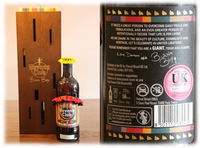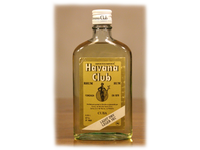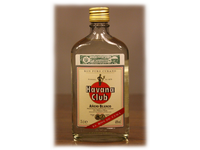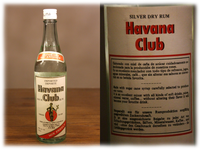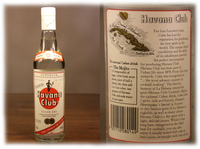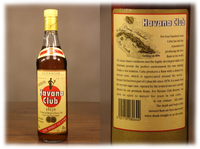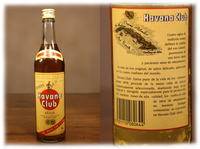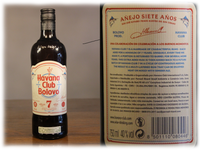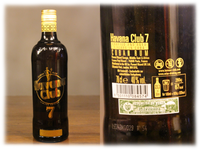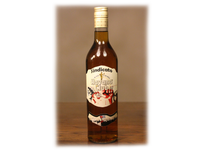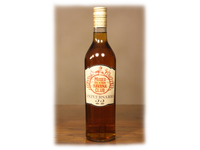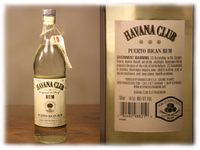The real story of Havana Club
Here you have the opportunity to get in touch with the history of Havana Club. I couldn't find any website or article that tells the complete story of this exciting history. In painstaking month of work in internet research I wrote down all details I found. Of course it could be happen that you find small mistakes (at most in my bad english). I'm very grateful for comments.
Sources were Wikipedia, family interviews I found in internet, rum websites and at most the original very rare biography of the 75th anniversary of Jose Arechabala S.A. in 1953. Most of the pictures are used from that book (until decline).
La Vizcaya 1878-1921 / Jose Arechabala S.A: 1921-1966 / Havana Club 1966-today
1847: José Arechabala Aldama was born in Gordejuela, Vizcaya, on November 9, 1847. The sources consulted not allude to childhood to adolescence, but it is likely that they weren’t nothing buoyant, because...
1863: ... with only 15 years he sought in Cuba better horizons. He arrived on the island on September 21, 1863
1860s/70s: He worked first with his relative Antonio Galíndez Aldama, based in Matanzas, and then at the Bea home, dedicated to the provision of ships, the hardware and banking, something frequent then when the companies assumed the role of banks.
1874: José marries Carmen Hurtado de Mendoza.
1878: 16 years later he chose Cardenas for his new home. He thought that this small city is the best place for his family to grow up. In 1878 entered to the game the Vizcaíno (Arechabala), who bought in installments to the heirs of Joaquín de Zulueta a still established in matancera city of Cardenas. He distilled the sweetness of seven or eight sugar mills in the area and received by sea raw Sagua la Grande and Yaguajay, and was valued at about 33 000 pesos gold and 167 000 pesos in bills..
1880: In February 1880 he registrated his small company "La Vizcaya" in the commercial register. The name means "The Biscay" and refers to his Basque origin. Cardenas was a new and young city with a port and a railway company. Growing prosperity spread to the entire region.
1884: Villa Carmen was built up. The home from José Arechabala
1888: A massive hurricane devastated the City and especially the distillery. The company ran in recent years so successful that he managed to rebuild ($ 50,000 total costs) from they own resources.
1890: José Fermin Iturrioz y Llaguno is born. grandnephew from founder Jose.
1895-1899: During the war independence from Spain Cardenas was almost completely destroyed. The international trade collapsed completely.
1902: José's grandnephew and godson , the 12 years old Jose Femin Iturrioz y "Josechu" worked in part-time jobs and plaster work for his uncle. But he was more interested into finish the school, instead of assuming a good job. Josechu was the son of his niece Juana Llaguno y Arechabala and a warehouse worker of the company Fermin Iturrioz Michelena, who lived in the house of Arechabala after the immigration from Spain to Cuba. The couple married in 1889.
1903: The sugar refinery was opened and so they had a second business.
1903 Josechu's father died. With just 13 years he was the head of his young family. He found a way of jobs in other companies in addition of his education and to support his family.
1907: With an age of 17 Josechu came back to the family business. Quickly he became a great businessman beside his godfather Don José.
1919: José's wife, Carmen died with a age of 65/66. In Santa Cruz del Norte was founded the small independently distillery Havana Club.
1920: The American prohibition started. Alcohol is illegal in the U.S.
1921: After the sales in recent years was grown very fast, Arechabala took over some other local companies on 18th January 1921. "José Arechabala S.A." was born. José was the first president with an age of 75. His son José Arechabala y Sainz was the first managing director. The company had 4 small transport ships. The location directly nearby the harbor was great.
1920s: The American citizen discovered Cuba (Havana) for gambling, prostitution and drinking alcohol, which is illegal in the U.S.. Bootlegging of alcohol from Cuba to the U.S. was becoming increasingly important. Carmelina Arechabala is born. She is the granddaughter of José and is considered the epitome of the it girls in Cuba. "a life like Carmelina" is still considered one of the most famous sayings in Cuba. She was born in one of the richest families in the country and enjoyed life, while nevertheless remained a popular personality.
1923: Company founder José Arechabala died on 15th March. He leaves his 5 children: Juana, Carmela, José Antonio "Toto", Mercedes and José Nicolás "Pepucho". José's remains are placed in the family tomb in Gordexola (Spain). He was responsible in Cardenas for the public lightning, because he manufactered the gas and built a theater that named "Arechabala Theater". His actions were a reflection of his dedication to the culture. He built a lot of green areas with parks. Cardenas was his adopted son. José's death is the beginning of many unfortunate family tragedies.
It is called that Toto's wife Nati, La Bilbainita died by the birth of their son. Even the newborn did not survive. Both have also been buried in Gordexola.
1924: Successor José Arechabala y Sainz was killed by kidnappers.
1926: Another son in law, Gabriel Malet y Rodriguez died. Later was the widow of the murdered son (José's) daughter the victim of criminal extortion. The local police catched the blackmailer when they dressed up as the daughter. After these hard years the family felt not really safe in Cuba. Many family members moved back to Spain. Some of them returned later, but most lived up to their end of life of dividends and profits from the company. Or from relatives who still worked in Cardenas. Josechu was chosen to be the new president.
1928-1933: 1928 Arechabala started difficult negotiations with the United States because of the export refined sugar. They retrated to 1933. Together with other companies they prevented the decline of the sugar refeneries.
1929: The New York stock market crash and the prohibition made many problems. The economy declined slowly. The railway company went to Havana, just like many other companies of this region. The harbor, the former economic hub of the region aged and the harbor in Havana was much better because the ships needed more depth and much more place than was given in Cardenas. In 1924 the politic decided a release of $ 700,000 subsidy to modernize the port. Also they planned a breakwater to protect the harbor. Thus, the economy of this region would be safe for 50 years. The government with Gerardo Machado stopped this project. The money was paid but was never seen again. The companies piers and docks were the only usable marinas at the harbor of Cardenas.
1930s: Josechu builds a new family residence with a lagoon and a park few miles away from Cardenas. The residence name was JosOne, acronym of his great-uncle (founder Jose) and his great-aunt. Today we know this area under the name: Varadero.
1931: The Mofuco engine plant was opened. It was used for the research and production of fuel in form of alcohol.
1933: Again a large hurricane destroyed Cardenas. The result were 33 dead's, over 100 injured and high damage costs ($ 500,000). It needed many month to rebuild and established the company again, just with they own resources. In addition they decided to modernize the harbor, also with own resources to remain in business.
1933: Prohibition ended. The company was hoping for export in the near future.
1934: On 19th of March the new company was opened with a new product. The birth of Havana Club. Immediately they started to export the new kind of rum into the U.S.. The recipe was owned by the Arechabala family till they sold it to Bacardi in 1997. He was considered as the best rum in the world. Month later Arechabala produced also medical alcohol. In the same year started to sell sweets on a stick with the newest technique and systems. The lollipop was born. After 3 years of research Arechabala S.A. started to produce gasoline based on alcohol.
1935: The world-famous Havana Club bar opened at the Plaza de la Cathedral in Havana on 29th May. At 31st of December Ramon Arechabala was born.
In 1936 opened the confectionery factory.
1939: The development of the harbor began. Talent, manpower and equipment were posed exclusively from Arechabala S.A.. After 5 years of hard work they completed a modern harbor, a new shoreline, new green areas, a Marina and a beach promenade.
1939: Arechabala S.A. brings out a magazine "Gordejuela Cardenas" which reports current topics in Cardenas, mainly related to the company. It points out especially the good relationship between employees and their supervisors.
1940s: Josechu was looking at any time for new business and to create new jobs. They started to produce jute bags and the confectionery production grew fast. During the second world war more than 1000 people worked for the company. Since two decades Arechabala S.A. was the biggest employer.
Carmelina went to one of the most famous it girls.
1943: Under the name of "Alcoelite" Arechabala S.A. began with the production of distilled alcohol. During the second world war gasoline was very rare. Arechabala S.A. produced 63% of the Cuban consumption. This was the reason why the ground transportation never stopped.
1944: The world was in world war II. But the prospects for economic success was almost limitless. The following years were very good and the company generated a lot of money.
1949: The company had 6 transport ships, 60 hectares premises and many sugar cane plantation.
1955: The Trademarks in Spain and the Dominican Republic ran out and were not renewed. Only José Arechabala could renew them.
1956: Their productions were over those of its competitors. In 1956 La Vizcaya produced around six million liters of spirits and spirit of 95 degrees, adding to what were the almost 800 000 litres obtained by force and progress stations. They followed him in production order distillery hell – more than six million litres – and the spirits of Cuba, with five million in brands of rum and cream Aldabo, cognac Peralta and anise. The Cuban company of Alcohol appears with more than three million liters, of Santa Cruz, and legendary names, while Bacardi appears only with 3 118 000 litres.
Late 1950s: Then came the turbulent 1950s , where the company got big financial problems. At most the late 50s were hard. Sugar was produced cheaper in other countries. And the rum production got big competition in Cuba and the Caribbean.
1959: On 1st of January 1959 Castro overthrew the Batista regime. In following month all owners from land, farms and businesses were expropriated without compensation. Everything was nationalized.
1959: On 31st of December 1959 special forces broke into the offices of Arechabala S.A.. Under threat of violence they confiscated all important papers and books. During the holidays many family members and senior family members were abroad at family celebration. Most of them didn't return because of anxiety of imprisonment. For many month family members and employees worked without payment. Lots of them escape and left Cuba vis Spain to the U.S. The state-owned enterprises Cubaexport took care of the business. The promise of a fair severance and to pay compensation was never respected. All businesses in Cuba were led by state inspectors in using of the originals trademarks.
Note: It is not clear if Arechabala S.A. was producing rum after 1955. It's disputed whether the Cuban government took over a bankruptcy company. Even the self-construction of the harbor and the investments in the region could be a reason of the financial problems. Also the cheap sugar cane production in other countries.
Another open issue is whether Josechu was still the president in the late 50s, or if he was replaced. Also missmanagement due to a change leadership could be the reason for the slow decline. According the rumors he was replaced in 1953 by Carmen Arechabala, a daughter of the founder and widow of Jose Arechabala Sainz, nephew of her father. Highest number of employees: 2650
Eventually the company named after 1959 (because of the takeover from the Castro regime?!?) into Jose Antonio Echeverria.
1960: The law 890 came out in October. It confirmed that all companies are state property. The U.S. embargo started with the first step. The U.S. import of sugar was reduced by 7 million tons.
After 1960 the company produced almost exclusively rum and rum liqueurs. This indicated in the previous years by the sugar crisis.
1962: In March the U.S. imposed a complete economic embargo to Cuba. It was prohibited to sell Cuban products or to have trade relations with cuban companies. But it was not prohibited to register Cuban trademarks by the US-Lanham or General InterAmerican Convention for Trademark and Commercial Protection (IAC).
In June Cardenas was the place of the first big demonstration against the new politic. The people were dissatisfied with the impact of the communist economic policies and restrictions on their freedoms. The supply situation had deteriorated significantly since the revolution of 1959, so that the government introduced the nationwide food rationing. The government sent soldiers and tanks from other parts of the country to Cardenas. Subsequently, the government let the tank go up in a military parade, which included artillery and overflights of combat aircraft. Supposedly there were many executions after.
1966: After being thrown out , the sales manager Ramon Arechabala fought with odd jobs. But whenever he established something, it was snatched by government. They distrust their own people because of the Bay of Pigs invasion. Ramon was sent to prison and he was allowed to decide: leave Cuba or to stay in prison for a long time. He flew via Madrid to Philadelphia and arrived finally Miami. He had nothing. Just the clothes he weared and his wife with kids. However, he knew the recipe of the Havana Club rum. He didn't stop the dream of producing rum again.
1966: The government renewed the on behalf of José Arechabala the trademark. Cubaexport generated an new Havana Club logo.
1969: On new year Josechu died as a broken man in New York.
1970s: After the movement to Santa Cruz del Norte Cardenas declined fast. Many people lost jobs. Till the 90s the population went from 70.000 people down to 20.000.
1970: The site in Cardenas moved to Santa Cruz del Norte. In a new built distillery.
1971: Don Jose Navarro is the new Maestro Ronero, til today (Feb. 2016)
1972: The Cuban government sold rum exclusively as Havana Club. Unlike as Bacardi Arechabala had no factories in other countries. So Cuba had no disputes about naming rights or trademarks.
1973: The brand protection "Havana Club" which was still owned by the Arechabala family was running out. But the family didn't renew it, because of trouble and ignorance.
1973-1993: 70% of the export went to the UdSSR or other east European countries.
1974: The former sales manager Ramon flew with his brother Miguel to Nassau (Bahamas), where Bacardi is headquartered. They checked the possibility to produce a Havana Club rum. Mr Pelaez didn't contact them again. Later they got the information that he was sick and died soon. In the same year the Arechabala family discussed to extend the trademark. But Javier the former company lawyer was still in prison in Cuba. Because of ignorance about the current legal situation in Cuba they did nothing.
1976: Because of not extending of the rights, Cubaexport registered the brand in 70 countries. But not in the U.S. because of the embargo.
1960s & 1970s: In the sixties and seventies many court cases took place in the U.S., where all original Cuban owner granted their trademarks back, which they had before the revolution.
1993: When the first rumors and newspaper articles about the forthcoming joint venture with Pernod Ricard were created, Ramon wrote a letter to Patrick Ricard. He told him that they can not produce a Havana Club rum without the original recipe from the Arechabala family. After a answer and the assurance to take care of this case a lawyer negotiated between the family and Pernod Ricard. The offer was ridiculous low and was rejected by the family (even they were angry because of making business with the Castro Regime). In that time time Ramon met again a family member from Bacardi (Mr Prado). they agreed to handover the rights to produce a Havana Club rum with the original recipe. Also for using the name.
1993: In November 1993 founded Cubaexport on the first site as owner of the distillery with Cuba Ron as central cuban distributor and Pernod Ricard on the other site a joint venture. Pernod Ricard is responsible for all sales activies outside of Cuba worldwide, while Cuba Ron sells products of Pernod Ricard in Cuba.
1993-2000: After the joint venture the revenue was increasing year by year for ten percentage and more.
1995: Notwithstanding of the expropriation by the cuban government in 1960, the Arechabala family sold the brand to Bacardi for supposedly $ 1,25 million. Bacardi began massive influence of the politics to enforce the trademark rights. Because after the law of 1994 extremely doubtful whether the Arechabala's were the owners of the rights (not extended in 1973). Bacardi exported 16 boxes of Havana Club rum to the U.S. Produced with the original recipe from the Arechabala family. The rights had been negotiated verbally in 1993 with Ramon Arechabala. At the same time Bacardi supported with campaign donations some senators. They forced the Helms-Burton Act (also called Bacardi Act), which provides that U.S. companies can take action against companies which are using expropriated ownership.
1996: After the law was adopted in March, Bacardi started with the export of Havana Club rum on 7 states in the U.S:. Then Pernod Ricard sued the distributor Galleon and Bacardi at the U.S. district court. Parallel to the subsequent process Bacardi expanded his lobbying. Jeb Bush for example (Governor from Florida) received for campaign donations $ 200,000. Bacardi hoped for support.
1997: After the verbally agreement from 1993, Ramon and Bacardi signed a formal agreement.
In 1998 a second law was which called Omnibus Appropriations was adopted. Section 211 of this law was written by by a Bacardi lobbyist. He got got $ 600,000. There was written that it is forbidden to entry or extend trademarks from former dispossessed Cuban owners in the U.S. Because of this law it was not possible to extend the rights from the Havana Club holding in the U.S. The WTO intervened and declared the section 211 illegal. The U.S. have been invited to abolished the law til 2004. Til today (Feb. 2016) this not happened. Finally the process needed so long that the trademark expired in August 2006. Because of the reason that Havana Club holding had no chance to register the trademark again there was no reason for a legal case. And the legal case was closed provisionally without judgment at final instance. Five days later Bacardi began again with selling his own Havana Club in the U.S., now produced in Puerto Rico.
1999: In Spain began also a process between Bacardi and Pernod Ricard about the Havana Club trademark. Bacardi lost in every instance. The company complained at the surpreme court of Spain. They rejected the complaint in 2011.
2000: Opening of the Havana Club Museum in Old Havana.
2007: In San Jose (Cuba) another distillery is opened. Havana Club said the costs were about $ 66,000,000. The most modern distillery in Cuba with a capacity of 12,0000 bottle per hour. They are just producing brown rum.
2008: The Havana Club rum is exported to 125 countries worldwide.
2010: Ramon Arechabala died on 10th February 2010.
2012: After the supreme court rejected a revision of the process, Pernod Ricard registered a new Trademark in the U.S.. "Havanista" is the brand for the U.S. market when the embargo will stop in the near future.
2014: US President Obama announces a loosening of the embargo and other approaches to Cuba.
2015: Pernod Ricard, made with the company as a whole (including all Liqueur, Whisky, Vodka etc.) revenue of $ 9.7 billion. Bacardi $ 4.48 billion only with Rum. They sells about 4 milliom 9-liter cases of Havana Club outside the U.S. a year.
2016: May; Bacardi announced that they will release 2 new Havana Club. You remember in the design very much of the 50s and 60s.
June; Pernod Ricard sees a great opportunity in the US market and announced to invest $ 90 million in Cuba in the coming years.
Overview of details and all produced and imported products for further processing of Arechabala S.A. in the late 50s:
Space for 2 million 147kg (325 lbs) bags of sugar
one of the most productive and most modern sugar refineries
Syrup
Molasses plant with a capacity of 5 million gallons
Oldest and largest distillery in Cuba
Petroleum plant
Commodity production for paper
Alcohol for motor industry
Sweets
Rum
Cognac
Industry petrol
Brandy
Marmelade
Honey
Cremes
About "Josechu" Arechabala
In spite of his great economic success, he never forgot his fellow man and cared for the need of the region and of the employees. He supported the church. He had no children, but treated his siblings relatives kids as his own. He was a very popular and respected man. Every year he drew the winner of a house paid by the company for one of his employees. He made no difference between black and white people.
Plot: Varadero Beach. After fleeing, the Castro regime used the estate for other heads of state. Salvatore Allende (Chile) and Leonid Brezhnev (Russia) were guests. After a couple of years they built up a park with restaurants and hotels for tourists. The Varadero which we know today.
Logo
La Giraldilla, is a woman statue on the tower of the Castillo de la Real Fuerza, is the symbol of Havana Club. She is supposedly Inés de Bobadilla, successor of her husband as the governor of Cuba in 1539. La Giraldilla, which is also the emblem of Havana is the symbol for loyalty and desire. She is printed on every bottle. The logo was created from Cubaexport, after the revolution.
